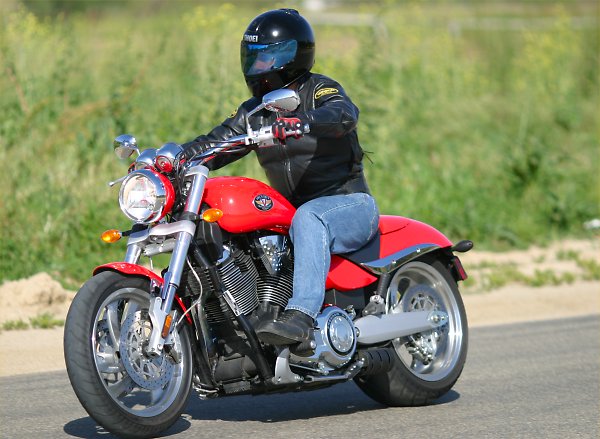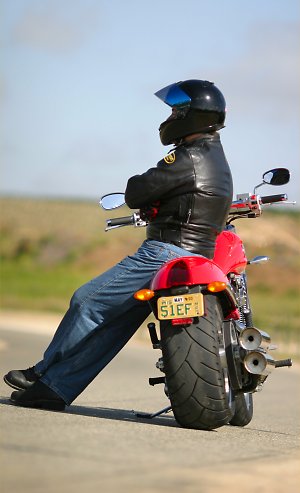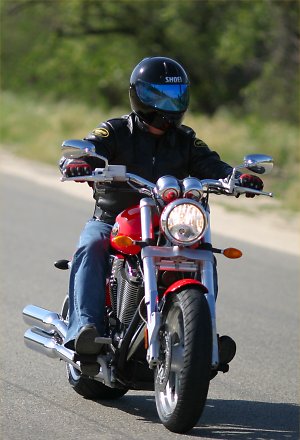
The cruiser market has experienced incredible growth in the last few years, fueled in part by the explosion of chopper-based reality tv show that started with Jesse James’ West Coast Choppers and moved to biker build-offs and more. It seems that although many of the people who watch these shows lust after the hard-tailed, fat-tired customs they see on TV, they can’t afford to foot the bill for a custom creation from the mind of a maniacal visionary like James. Thus, many of these chopper fans end up on regular, mass-production cruisers straight off the showroom floor.
The big manufacturers know these facts as well as we do, and thus it was inevitable that they would try to use some of the styling cues from the big-dollar customs on their production cruisers. The Victory Hammer is a result of one of these trends – namely, the ultra-wide rear tire.
We wouldn’t exactly classify the Hammer as a “power cruiser”, although it is in fact as powerful as many of the bikes that receive that label. Victory may have created its own category with the Hammer; let’s just call it a “muscle cruiser”.

Muscular is definitely a word that fits with the Hammer. The huge rear fender wraps closely (well, as closely as possible on a bike that actually has rear suspension) over the massive 250mm-wide rear Dunlop. Up front, the fat look continues with big 43mm inverted forks, carrying 300mm discs and 4-piston Brembo calipers.
Victory’s new 100ci (1634cc) V-Twin is exclusive to the Hammer (for now, at least), and it packs the power to back up the bike’s intimidating looks. The air-cooled twin is fuel-injected and counterbalanced for smoothness, and up top you’ll find a single overhead camshaft actuating 4 valves per cylinder. These valves feed the slightly undersquare (101mm x 102mm bore x stroke) bottom end, sucking air through 44mm throttle bodies to be compressed by 9.8:1 compression pistons.
The new powerplant is also attached to an all-new transmission, featuring 6 speeds with the top gear being an overdrive designed to keep the rpm low during highway cruising. The transmission turns the rear wheel by means of a belt drive featuring a carbon-fiber reinforced belt.
All these specs are impressive, but the dominant theme of the Hammer revolves around the massive rear tire. Victory claims the 250/40R18 Dunlop Elite 3 is the widest rear tire ever fitted to a production bike, and we believe them. The tire’s characteristics make the Hammer a somewhat “interesting” ride.
The wide, flattened profile of the tire makes the Hammer resistant to turning. Significant countersteer effort is necessary to initiate turn-in, particularly at low speeds. On most bikes the required countersteering gets lighter once leaned over, but not on the Hammer. The bike constantly wants to stand up mid-corner, and firm pressure needs to be continuously applied to the inside grip to counteract this tendency.
That may sound pretty disconcerting, but once you get used to it it’s really not that bad. In higher-speed sweepers it is easy to hold a fairly consistent line on the Hammer, and the bike actually takes to the sweepers as well as most cruisers once you learn how to deal with the unusual handling.

One problem we found with the tire’s unusual profile (see photo) was a disconcerting feel when you try to lean the bike over onto the very edge of the tire. While the middle 90% of the tire is nearly flat, it falls away steeply in the last 5% on each side. On most cruisers lean angle is limited by ground clearance, but on the Hammer we found it limited by our own reluctance to lever the bike up onto this last angled section of tire. Particularly at low speeds (as when making a 90 degree right turn at an intersection), the bike is anything but confidence inspiring when using this section of the tire. In fact, it feels like it just might fall over unexpectedly. We believe this sensation is caused in part by the previously described unusual tire profile and in part by the tire’s extreme width, which has the effect of levering the back end away from the ground and out of line with the front end when fully leaned over.
Again, this may sound difficult to cope with, but in reality it is a simple matter of limiting your lean angle to avoid the issue. Once you get used to riding the Hammer the way it wants to be ridden, it’s not much different from riding any other cruiser. It might be easier for bigger riders, as the required countersteering effort did tend to become a little tiring for the author (5’9″ 140 pounds).
For a rider looking for the wide-tire styling that the Hammer possesses, we feel that it is certainly an excellent choice. While we haven’t ridden any of the aftermarket specials with similar rear-tire widths, we expect that the Hammer’s handling is about as good as it gets with a rear tire this big. Smaller custom makers just don’t have the resources to develop a bike’s handling around an incredibly wide tire, as Victory did with the Hammer.

On to the rest of the bike. The Hammer’s ergonomics are as comfortable as any cruiser we’ve ridden, with a nice seat and an excellent seat/peg/bar relationship. The pegs in particular are far enough forward to be comfortable during long-term cruising, without being far enough forward to engender any uncomfortable feeling during low-speed maneuvering. Vibration from the big V-Twin is noticeable but not uncomfortable – you mainly feel it through the bars, and there’s just enough to remind you that you’re straddling a big-displacement V-twin. We never experienced any hand or foot numbness while riding the Hammer.
The Hammer suffers the typical drawbacks of any unfaired cruiser during high-speed highway travel – the riding position conspires to turn the rider into a human sail, and the windblast makes it difficult to hang on to the bike at anything above 70mph. However, if you’re planning to buy in this category, you should be expecting similar characteristics from any of the bikes available.
Pulling away from a stop, you immediately feel the smooth torque of the 100ci V-twin. The motor is smooth and has an incredibly broad spread of power, making gear selection nearly irrelevant once moving. The fuel injection mapping is excellent and features an impressively smooth transition from closed to open throttle – a difficult feat on a torquey v-twin and one that has rarely been achieved this well. Overall, we feel that the Hammer has one of the best, if not the best, motors available in similar displacement on any cruiser. Another impressive accomplishment, particularly for a relatively small company like Victory competing against the massive developement resources of companies like Honda, Yamaha, and Harley-Davidson.
The six-speed transmission also works well, although we occassionally experienced problems upshifting at full throttle in the higher rpm range, particularly from third to fourth. We did find that six speeds are a little redundant on a bike with this much torque – after about an hour of riding I developed a new shift pattern, clicking through the gears one-two-four-six when pulling away from a stop and accelerating up to speed. The ratio of the overdrive sixth is excellent for keeping the rpm low when cruising, but honestly the bike would have been fine with a five-speed or even a four-speed – it has that much torque!

We were particularly impressed with the durability of the Hammer’s multi-plate wet clutch. While shooting photos, we attempted to do a burnout picture. The usual procedure for this (well known to any hooligan rider) goes like this: stop, hold front brake, bring revs up and slip clutch until rear tire breaks loose, then hold throttle open until sufficient smoke develops to make for a good photo. However, when we attempted this procedure with the Hammer, we discovered that even this bike’s powerful torque wasn’t enough to break loose the massive 250mm rear tire. We made several attempts, slipping the clutch and applying enough torque to fully bottom the front forks, to no avail. We doubt many clutches could endure that kind of punishment, but the Hammer gave no sign of protest and the clutch seemed to work just as well afterwards as it had before. This incident demonstrated something else – if you’re planning to drag race, or even just enjoy blasting away from stoplights, the incredible straight-line traction of the Hammer could definitely be useful!
Lots of power combined with a heavy cruiser can sometimes mean difficulty stopping, but not on the Hammer. The Brembos provide excellent power and good feel, more than enough to haul down the 657lb (claimed dry weight) Hammer with authority.
The Hammer has a lot of good traits, but in our opinion one of the best is its appearance. Styling is always subjective, but it’s hard not to like the low, muscular stance and attractive curves of the Hammer. The rear and rear 3/4 views are particularly impressive, as the huge rear tire just makes the bike look, well, tough. The engine is gorgeous, with a powerful shape and excellent finish. In fact, the finish on all components was excellent, adding yet another check mark in the ‘+’ box on Victory’s scorecard.
Overall, despite the unusual handling resulting from the big rear tire, we were very impressed with the Hammer. Appearance and image are extremely important in the cruiser category, and the Hammer definitely has both in spades. We got a lot of looks while rolling down the road, certainly more than you would receive on a more generic-looking showroom cruiser. To a lot of buyers in this segment, that will be extremely important. If you are looking for a powerful, fun-to-ride cruiser with more of a custom look than most other offerings, you won’t be dissapointed with the Hammer.
The 2005 Victory Hammer carries a U.S. MSRP of $16,499. More information is available at Victory’s web site.






